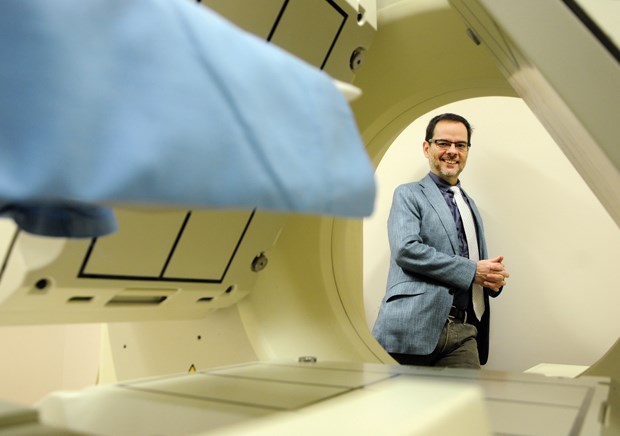A Lions Gate Hospital psychiatrist and nuclear medicine specialist is winning high praise for a far-reaching study that could change the way we diagnose and treat patients with post-traumatic stress disorder and traumatic brain injury.
Dr. Rob Tarzwell and a team of researchers compared more than 21,000 single-photon emission tomography (SPECT) images of brains of people clinically diagnosed with PTSD, TBI or a combination of both. They found they were able to predict with 100 per cent accuracy which condition or conditions their subjects had.
“This is the largest functional neuroimaging study in history and that allowed us to have a lot more confidence in our statistical results,” Tarzwell said. “The data have been murky. This is the first time a clear and convincing difference has been demonstrated.”
Discover Magazine placed it on their list of the top 100 science stories of 2015.
While people with brain injuries tend to have decreased neuron activity and blood flow to the frontal lobes of the brain, PTSD patients have overactive segments in their lower brain structure, as revealed by SPECT images. The trouble is, both conditions tend to produce the same symptoms: decreased impulse control, amnesia, insomnia, irritability, reduced frustration tolerance, low mood and energy.
Knowing the physiological difference between the two means clinicians should be able to make much more targeted treatments, Tarzwell said. “Somebody with traumatic brain injury already has an underactive brain. You don’t want to necessarily add sedatives to the picture, whereas with PTSD, which is an anxiety disorder, sedatives can play a really important role.”
Yet, close to two-thirds of patients with TBI are put on sedatives at some point in their treatment, Tarzwell said. The research is of particular interest to doctors whose patients have suffered trauma of both kinds. “One of the groups we’re especially interested in is situations where things that damage your soul also damage your brain. These would be physical assaults, motor vehicle accidents, police incidents, war,” he said.
Tarzwell called being in the top 20 of Discovery’s annual list a career highlight. “We were number 19 on that list this year. That felt wonderful. We’re one behind Tesla’s announcement of home battery packs so we’re in pretty good company and eight out of the top 10 were pictures from Pluto. Who knows, if it wasn’t a good planetary exploration year, we might have done even better,” he said. “I don’t know if I’ll ever punch this high above my weight again.”
The study’s methods are replicable for most any psychiatric conditions and the database of brain images has more than 100,000 subjects to compare, meaning Tarzwell’s work could act as a new foothold in the study of neurobiology. Using data collected at Lions Gate Hospital, Tarzwell’s next study delves into the differences in neurobiological patterns linked with bipolar and unipolar depression.
“The treatments are starkly different. In fact, the treatment for one can be dangerous for the other. That’s a clinically important question that’s never had a satisfactory resolution and a lot of patients with bipolar disorders can go 10 or more years with no proper diagnosis and end up on the wrong pathway. It’s as common as dirt,” he said.



